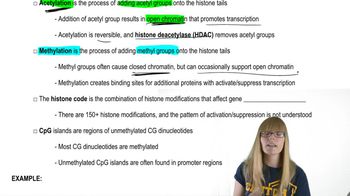Table of contents
- 1. Introduction to Genetics51m
- 2. Mendel's Laws of Inheritance3h 37m
- 3. Extensions to Mendelian Inheritance2h 41m
- 4. Genetic Mapping and Linkage2h 28m
- 5. Genetics of Bacteria and Viruses1h 21m
- 6. Chromosomal Variation1h 48m
- 7. DNA and Chromosome Structure56m
- 8. DNA Replication1h 10m
- 9. Mitosis and Meiosis1h 34m
- 10. Transcription1h 0m
- 11. Translation58m
- 12. Gene Regulation in Prokaryotes1h 19m
- 13. Gene Regulation in Eukaryotes44m
- 14. Genetic Control of Development44m
- 15. Genomes and Genomics1h 50m
- 16. Transposable Elements47m
- 17. Mutation, Repair, and Recombination1h 6m
- 18. Molecular Genetic Tools19m
- 19. Cancer Genetics29m
- 20. Quantitative Genetics1h 26m
- 21. Population Genetics50m
- 22. Evolutionary Genetics29m
13. Gene Regulation in Eukaryotes
Epigenetics, Chromatin Modifications, and Regulation
Problem 24c
Textbook Question
Methylation of H3K9 by itself silences genes, but if H3K4 and H4K20 are also methylated, the combination of modifications stimulates transcription. What conclusions can you draw about this?
 Verified step by step guidance
Verified step by step guidance1
span>Understand the role of histone methylation: Histone methylation is a type of epigenetic modification that can either activate or repress gene expression depending on the specific histone and lysine residue that is methylated.</span
span>Identify the specific histone modifications: H3K9 methylation is generally associated with gene silencing, while methylation of H3K4 and H4K20 is often linked to gene activation.</span
span>Consider the combination of modifications: The presence of multiple methylation marks (H3K9, H3K4, and H4K20) suggests a complex regulatory mechanism where the combination of these marks can lead to different transcriptional outcomes.</span
span>Analyze the potential interactions: The combination of these methylation marks might create a unique chromatin environment that is recognized by specific proteins or complexes that can either activate or repress transcription.</span
span>Draw conclusions: The presence of H3K4 and H4K20 methylation alongside H3K9 methylation indicates that the overall effect on transcription is context-dependent, and the combination of these marks can override the silencing effect of H3K9 methylation alone, leading to gene activation.</span
 Verified video answer for a similar problem:
Verified video answer for a similar problem:This video solution was recommended by our tutors as helpful for the problem above
Video duration:
1mPlay a video:
Was this helpful?
Key Concepts
Here are the essential concepts you must grasp in order to answer the question correctly.
Histone Methylation
Histone methylation is a post-translational modification where methyl groups are added to specific amino acids on histone proteins. This process can influence gene expression by altering chromatin structure, either promoting or repressing transcription. The specific effects depend on which histone residues are methylated and the context of other modifications.
Recommended video:
Guided course

Histone Protein Modifications
Transcriptional Regulation
Transcriptional regulation refers to the mechanisms that control the rate of gene expression. It involves various factors, including transcription factors, enhancers, and epigenetic modifications like histone methylation. The interplay between activating and repressing marks on histones can determine whether a gene is turned on or off, highlighting the complexity of gene regulation.
Recommended video:
Guided course

Eukaryotic Transcription
Epigenetic Interactions
Epigenetic interactions involve the complex relationships between different epigenetic modifications, such as methylation and acetylation, that can influence gene expression. The presence of multiple modifications on histones can create a 'code' that determines the transcriptional outcome. For instance, the combination of H3K9 methylation (which silences) with H3K4 and H4K20 methylation (which activates) suggests a nuanced regulatory mechanism that can switch gene expression states.
Recommended video:
Guided course

Interacting Genes Overview





